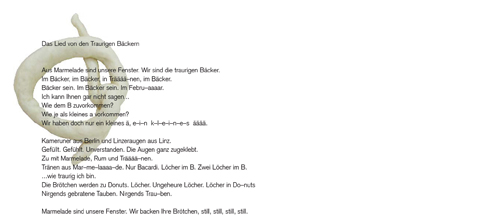Lisa Holzer
Laughing with Lacan
Laughing with Lacan

Does an omelette fit under a door? And what, pray, is a door anyway? The questions posed by Lisa Holzer’s works may not be the most obvious ones, but they sure are funny. In her recent series of collages, these questions must be taken literally: Omelette passing under door (2012) is a photograph of a Japanese omelette (a particularly thin variety) that’s rolled on a sheet of cellophane and lies on a kind of green screen. The whole thing disappears under a door with strange coffering that recalls the grooves on a bar of chocolate. The superimposed website address, parts of which are still visible, at least suggests that the image of the door is something Holzer found on the Internet.
The focus here is not so much on food as on exploring the principle of flatness, in several senses: as a motif (the omelette), as an aesthetic (computer-generated images whose sculptural appearance is intended to evoke depth) and as a joke that falls flat. In other works in the Passing Under series, Holzer varies this principle with motifs that appear increasingly arbitrary: a blue colour field is placed under bleaching shampoo, a Kinder chocolate egg rests under a poem, and nail varnish is found below rectangles of colour that turn out to be photographs of the streaky surfaces of cocoa or carrot juice. For some people, songs can be bridges – for Holzer everything is a door. And there is method in her constant repetition, hollowing out the specific motifs to the verge of randomness: the motif of the door gives her work the illusion of a space behind the picture, of unknown depths beneath the surface. So what’s behind the door? What’s behind all these ‘flat’ pictures? The answer, in most cases, is: text.

The idea of the flat omelette, for example, was borrowed by Holzer – who also runs a publishing house, Westphalie, with fellow Viennese artist David Jourdan – from Jacques Lacan. The French psychoanalyst uses the diminutive ‘hommelette’ (‘little man’) and its homonymy with ‘omelette’ to introduce the concept of desire as unity (the egg), or, more precisely, not desire itself but the ‘object cause of desire’ or ‘objet petit a’. This ‘objet petit a’ is less the actual object of desire than an original lack, a missing object that actually makes desire what it is: a constant insisting, a forever unfulfilled wishing for oneness, a (life-)long lean period. For some years now, the ‘objet petit a’ has been a thread running through Holzer’s work, where it seems to insistently, constantly return in new variations. The nature of this object is finally of no importance, but in most cases it is the most ordinary thing in the world: an omelette, a surprise egg (whose hidden secret we desire even though it’s always just cheap plastic bric-a-brac), cocoa, nail varnish.
In spite of this, Holzer’s work is not overloaded with theory. Of course the context of post-Structuralist psychoanalysis is a presence, but according to Holzer the reference to Lacan itself works like a gap that sets the projective capacity of desire in motion – in this case the viewer’s desire for content, superstructure, meaning behind the picture. The ‘objet petit a’ functions not as content (it doesn’t actually exist) but as a picture-making strategy that often generates gleefully silly results (this banality is also entirely in keeping with the concept). One early series, for example, is simply based on the spaces in the bellies of letters – what typographers refer to as ‘counters’ – as rudimentary graphical forms (as in Drunken B-Holes (Summer Dreamin’) and a (objet petit a), both 2009). In her associative texts, written in German or English or both, Holzer also usually works with direct references and links. For example, alongside a picture of a blob of ketchup entitled Ich bin nicht da (I’m not there, 2011), she places a ‘song to pictures, pictures of ketchup’. The song is called I am not there (2011) and it contains a dedication to Mayo Thompson, the singer from The Red Krayola – for the very simple reason that ketchup and mayo go so well together.

Holzer’s works also often include text fragments printed in very small type, what she refers to as ‘text blots’, so small as to be almost indecipherable. Many of these texts read like poems and songs, with a clear rhythmic structure. Made to be recited, their elongated vowels – their aaaa’s, uaaa’s and oooo’s – evoke the sound of a voice. An imaginary speaker starts to appear within the text – bringing a bodily dimension after all to Holzer’s otherwise emphatically flat, two-dimensional pictures.
Translated by Nicholas Grindell















